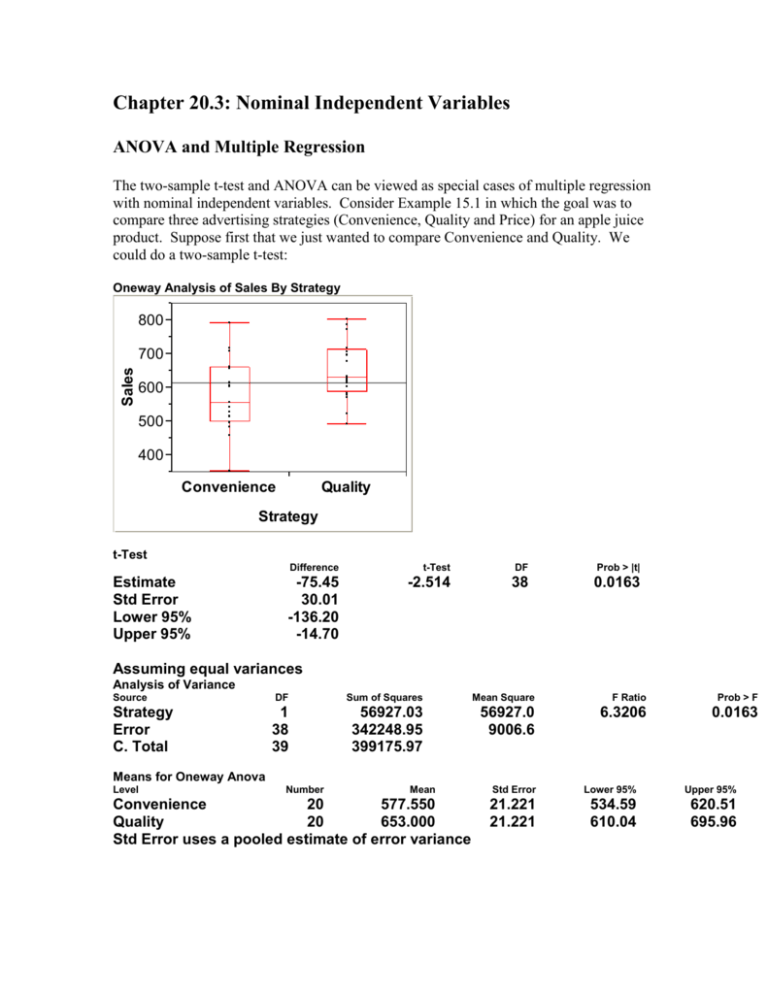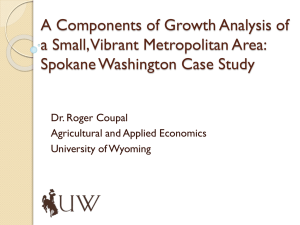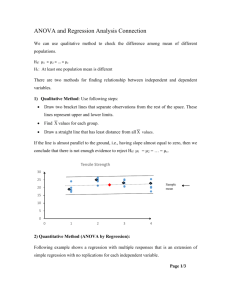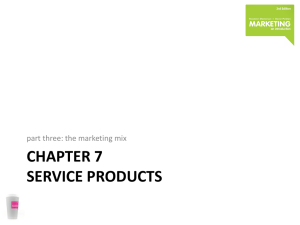Nominal Variables Examples
advertisement

Chapter 20.3: Nominal Independent Variables ANOVA and Multiple Regression The two-sample t-test and ANOVA can be viewed as special cases of multiple regression with nominal independent variables. Consider Example 15.1 in which the goal was to compare three advertising strategies (Convenience, Quality and Price) for an apple juice product. Suppose first that we just wanted to compare Convenience and Quality. We could do a two-sample t-test: Oneway Analysis of Sales By Strategy 800 Sales 700 600 500 400 Convenience Quality Strategy t-Test Estimate Std Error Lower 95% Upper 95% Difference t-Test DF Prob > |t| -75.45 30.01 -136.20 -14.70 -2.514 38 0.0163 Assuming equal variances Analysis of Variance Source Strategy Error C. Total DF Sum of Squares Mean Square F Ratio Prob > F 1 38 39 56927.03 342248.95 399175.97 56927.0 9006.6 6.3206 0.0163 Means for Oneway Anova Level Number Mean Convenience 20 577.550 Quality 20 653.000 Std Error uses a pooled estimate of error variance Std Error Lower 95% Upper 95% 21.221 21.221 534.59 610.04 620.51 695.96 We could also consider a regression model. Let I1 0 if Convenience and I1 1 if Quality. A regression model would look like this Y 0 1 I 1 . Bivariate Fit of Sales By I1 800 Sales 700 600 500 400 -0.2 0 .2 .4 .6 .8 1 1.2 I1 Linear Fit Linear Fit Sales = 577.55 + 75.45 I1 Summary of Fit RSquare RSquare Adj Root Mean Square Error Mean of Response Observations (or Sum Wgts) 0.142611 0.120048 94.90285 615.275 40 Analysis of Variance Source Model Error C. Total DF Sum of Squares Mean Square F Ratio 1 38 39 56927.03 342248.95 399175.97 56927.0 9006.6 6.3206 Prob > F 0.0163 Parameter Estimates Term Intercept I1 Estimate Std Error t Ratio Prob>|t| 577.55 75.45 21.22092 30.01092 27.22 2.51 <.0001 0.0163 Notice that the coefficient on I1 equals the difference between the mean of quality (I1=1) and the mean of convenience (I1=0). This makes sense because the coefficient on I1 is the average change in sales for a one unit increase in I1. This just equals the difference between the mean of quality and the mean of convenience. Also notice that the p-value for testing whether I1=0 is the same as the p-value for the two-sided t-test. What happens if we also want to incorporate the price strategy into the analysis, i.e., use a one-way ANOVA with three levels for convenience, quality and price? The one-way ANOVA analysis is the following: Oneway Analysis of Sales By Strategy 800 Sales 700 600 500 400 Convenience Price Each Pair Student's t 0.05 Quality Strategy Oneway Anova Summary of Fit Rsquare Adj Rsquare Root Mean Square Error Mean of Response Observations (or Sum Wgts) 0.101882 0.07037 94.31038 613.0667 60 Analysis of Variance Source Strategy Error C. Total DF Sum of Squares Mean Square F Ratio Prob > F 2 57 59 57512.23 506983.50 564495.73 28756.1 8894.4 3.2330 0.0468 Means for Oneway Anova Level Number Mean Convenience 20 577.550 Price 20 608.650 Quality 20 653.000 Std Error uses a pooled estimate of error variance Means Comparisons Dif=Mean[i]Mean[j] Quality Price Convenienc e Quality Price Convenience 0.000 -44.350 -75.450 44.350 0.000 -31.100 75.450 31.100 0.000 Std Error Lower 95% Upper 95% 21.088 21.088 21.088 535.32 566.42 610.77 619.78 650.88 695.23 Alpha= 0.05 Comparisons for each pair using Student's t t 2.00247 Abs(Dif)LSD Quality Price Convenienc e Quality Price Convenience -59.721 -15.371 15.729 -15.371 -59.721 -28.621 15.729 -28.621 -59.721 Positive values show pairs of means that are significantly different. There is a multiple regression equivalent to the ANOVA but it involves creating two dummy variables: I1 1 if quality, I1 0 if convenience or price and I 2 1 if price, I 2 0 if convenience or quality. The regression model looks like this: Y 0 1 I 1 2 I 2 In this case the intercept 0 represents the mean for convenience, 0 1 represents the mean for quality and 0 2 represents the mean for price. 1 represents the difference between the means for quality and convenience and 2 represents the difference between the means for price and convenience. Response Sales Whole Model Actual by Predicted Plot Sales Actual 800 700 600 500 400 400 500 600 700 800 Sales Predicted P=0.0468 RSq=0.10 RMSE=94.31 Summary of Fit RSquare 0.101882 RSquare Adj Root Mean Square Error Mean of Response Observations (or Sum Wgts) 0.07037 94.31038 613.0667 60 Analysis of Variance Source Model Error C. Total DF Sum of Squares Mean Square F Ratio 2 57 59 57512.23 506983.50 564495.73 28756.1 8894.4 3.2330 Prob > F 0.0468 Parameter Estimates Term Intercept I1 I2 Estimate Std Error t Ratio Prob>|t| 577.55 75.45 31.1 21.08844 29.82356 29.82356 27.39 2.53 1.04 <.0001 0.0142 0.3014 Effect Tests Source I1 I2 Nparm DF Sum of Squares F Ratio Prob > F 1 1 1 1 56927.025 9672.100 6.4003 1.0874 0.0142 0.3014 Sales Residual Residual by Predicted Plot 200 100 0 -100 -200 400 500 600 700 800 Sales Predicted Notice that the coefficients on I1 and I2 are the difference in sample means between quality and convenience and between price and convenience respectively. Also notice that the p-value for the F-test of H 0: 1 2 0 is identical to the p-value of the F-test from one-way ANOVA of the hypothesis that the means of convenience, quality and price are equal. This is the case because H 0: 1 2 0 is equivalent to the means of convenience, quality and price being equal. Combining Nominal Independent Variables and Continuous Independent Variables Multiple linear regression can accomodate both categorical independent variables and continuous independent variables. For example (Keller and Warrack, section 20.3), suppose you want to predict used-car prices from their odometer reading and their color (white, silver and other). To represent the situation of three possible colors, we need two indicator variables. In general to represent a nominal variable with m possible categories, we must create m 1 indicator variables. Here, we create two indicator variables. I1 1 if the color is white = 0 if the color is not white I 2 1 if the color is silver 0 if the color is not silver The category “Other colors” is defined by I1 0; I 2 0 . Our regression model is Y 0 1 X 1 2 I 1 3 I 2 where X 1 equals odometer reading. Response Price Whole Model Actual by Predicted Plot Price Actual 16000 15500 15000 14500 14000 13500 13500 14500 15500 Price Predicted P<.0001 RSq=0.70 RMSE=284.54 Summary of Fit RSquare RSquare Adj Root Mean Square Error Mean of Response Observations (or Sum Wgts) 0.69803 0.688594 284.5421 14822.82 100 Analysis of Variance Source Model Error C. Total DF Sum of Squares Mean Square F Ratio 3 96 99 17966997 7772564 25739561 5988999 80964 73.9709 Prob > F <.0001 Parameter Estimates Term Intercept Estimate Std Error t Ratio Prob>|t| 16700.646 184.3331 90.60 <.0001 Term Odometer I-1 I-2 Estimate Std Error t Ratio Prob>|t| -0.05554 90.481959 295.47602 0.004737 68.16886 76.36998 -11.72 1.33 3.87 <.0001 0.1876 0.0002 Effect Tests Source Nparm DF Sum of Squares F Ratio Prob > F 1 1 1 1 1 1 11129137 142641 1211971 137.4575 1.7618 14.9692 <.0001 0.1876 0.0002 Odometer I-1 I-2 Price Residual Residual by Predicted Plot 800 600 400 200 0 -200 -400 -600 -800 13500 14500 15500 Price Predicted The interpretation of the coefficient 90.48 on I1 is that a white car sells, on the average, for $90.48 more than a car of the “Other Color” category with the same number of odometer miles. The interpretation of the coefficient 295.48 on I2 is that a silver color car sells, on the average for $295.48 more than a car of the “Other color” category with the same number of odometer miles. The interpretation of the cofficient -.05554 on odometer is that for two cars of the same color that differ in odometer by one, the car with an additional mile on the odometer sells for 5.55 cents less on average. For each color car, there is a regression line for how the average price depends on odometer ( X 1 ). The regression lines for each color car are parallel. The indicator variables can be interpreted as shifting the intercepts of the regression lines. See the picture on page 708: For white cars: Yˆ (16700.65 90.48) .056 X 1 16791.13 .056 X 1 For silver cars: Yˆ (16700.65 295.48) .056 X 16996.13 .056 X 1 1 For all other cars: Yˆ 16700.65 .056 X 1 . Note: We will not consider it but it would be wise to investigate whether there was an interaction between color and odometer. A more general multiple regression model which would allow for different slopes and intercepts for each color of car would be Y 0 1 X 1 2 I 1 3 I 2 4 X 1 * I 1 5 X 1 * I 2 . Example: Problem 20.23 The president of a company that manufactures car seats has been concerned about the number and cost of machine breakdowns. The problem is that the machines are old and becoming quite unreliable. However, the cost of replacing them is quite high, and the president is not certain that the cost can be made up in today’s slow economy. In Exercise 18.85, a simple linear regression model was used to analyze the relationship between welding machine breakdowns and the age of the machine. The analysis proved to be so useful to company management that they decided to expand the model to include other machines. Data were gathered for two other machines. These data as well as the original data are stored in file Xr20-23 in the following way: Column 1: Cost of repairs Column 2: Age of machine Column 3: Machine (1= welding machine; 2= lathe; 3=stamping machine) (a) Develop a multiple regression model (b) Interpret the coefficients (c) Can we conclude that welding machines cost more to repair than stamping machines if the machines are of the same age? Solution: (a) Y=Cost of repairs. We want to include as independent variables both the continuous variable Age of Machine ( X 1 ) and the nominal variable Machine. To include the nominal variable, we need to create two indicator variables (because the nominal variable takes on three values). Let I1 1 if the machine is a welding machine = 0 if the machine is not a welding machine I 2 1 if the machine is a lathe 0 if the machine is not a lathe Our multiple regression model is Y 0 1 X 1 2 I 1 3 I 2 Response Repairs Whole Model Actual by Predicted Plot Repairs Actual 500 400 300 200 100 100 200 300 400 500 Repairs Predicted P<.0001 RSq=0.59 RMSE=48.591 Summary of Fit RSquare RSquare Adj Root Mean Square Error Mean of Response Observations (or Sum Wgts) 0.593778 0.572016 48.59141 340.6457 60 Analysis of Variance Source Model Error C. Total DF Sum of Squares Mean Square F Ratio 3 56 59 193271.36 132223.03 325494.39 64423.8 2361.1 27.2852 Prob > F <.0001 Parameter Estimates Term Intercept Age I-1 I-2 Estimate Std Error t Ratio Prob>|t| 119.25213 2.538233 -11.75534 -199.3737 35.00037 0.402311 19.70184 30.71301 3.41 6.31 -0.60 -6.49 0.0012 <.0001 0.5531 <.0001 Effect Tests Source Age I-1 I-2 Nparm DF Sum of Squares F Ratio Prob > F 1 1 1 1 1 1 93984.714 840.574 99497.022 39.8050 0.3560 42.1397 <.0001 0.5531 <.0001 Residual by Predicted Plot Repairs Residual 150 100 50 0 -50 -100 100 200 300 400 500 Repairs Predicted The residual by predicted plot does not show any gross departures from a random scatter. (b) For each additional month of age, repair costs increase on average by $2.54 for machines of the same type; welding machines cost on average $11.76 less to repair than stamping machines for the same age of machine; lathes cost on average $199.40 less to repair than stamping machines for the same age of machine. (c) To test whether welding machines cost more on average to repair than stamping machines if the machines are of the same age, we want to test whether the coefficient on I-1 is zero, i.e., we want to test H 0 : 2 0 . The p-value for the two-sided test is 0.5531. Thus, there is not enough evidence to conclude that welding machines cost more on average to repair than stamping machines if the machines are of the same age. Practice Problems from Chapter 20: 20.6, 20.8, 20.20, 20.24









